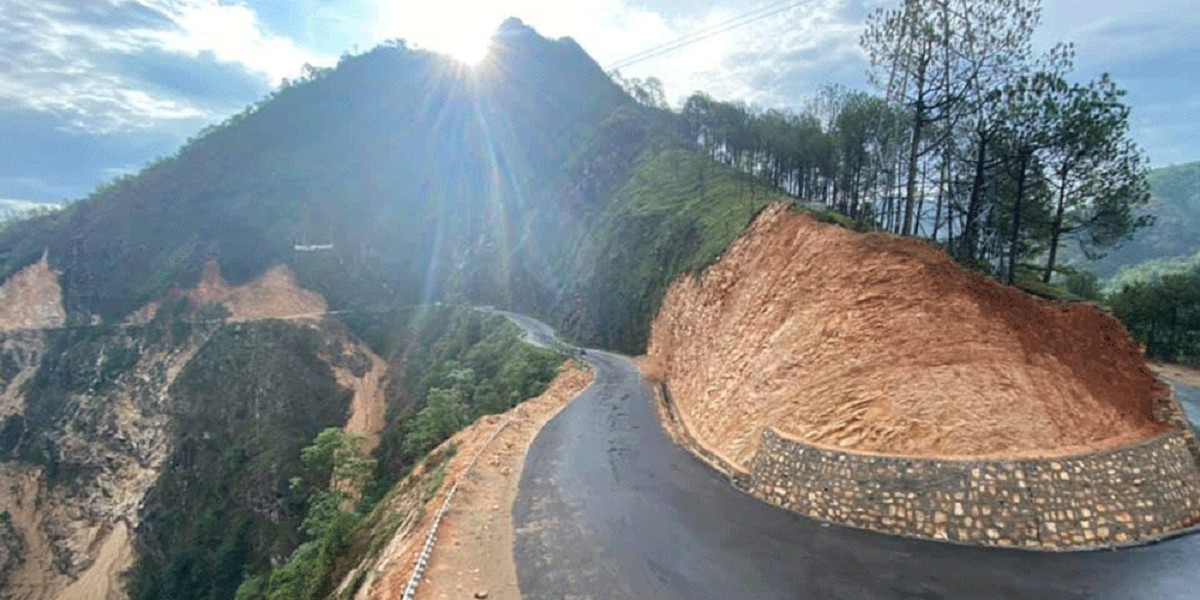Kathmandu: The interim government is preparing to advance the Pokhara–Bhairahawa Siddhartha Highway as a “game-changer project” to revitalize Nepal’s economy.
In the current fiscal year’s budget, the government has announced plans to upgrade this road section into a dedicated double-lane highway.
Clause 151 of the budget states that “considering its high potential for tourism promotion and economic expansion, work will begin to upgrade the Siddhartha Highway into a dedicated double-lane road,” and it will be implemented accordingly.
The goal of upgrading the Pokhara–Bhairahawa Siddhartha Highway to a double lane was to transform it into an economic corridor that could also bring in a large number of tourists from India — thereby contributing significantly to the national economy.
After the previous interim government cut budgets for small and fragmented infrastructure projects, this plan had fallen into limbo. However, current Finance Minister Rameshore Khanal has resumed groundwork to advance it as a “game-changer project.”
According to the Ministry of Finance, Minister Khanal is preparing to develop this 158-kilometre road section as an expressway.
“The government plans to announce the implementation of this project within the month of Kartik,” a ministry source told Clickmandu. “Once implemented, tourists from India will be able to travel directly to Pokhara. They can visit various religious and tourist sites in Lumbini, travel to Pokhara, and even reach Mustang easily. Moreover, trade costs between Nepal and India will decline, directly benefiting Nepal’s economy.”
If the highway is completed, it will also connect Gorakhpur — one of India’s major industrial cities — with Pokhara and Bhairahawa, developing the route as a commercial and industrial corridor. The area has sufficient water sources and vast flat lands, making it highly suitable for industrial and commercial activities. There are also plans to establish industrial zones along the highway.
Finance Minister Khanal has already instructed the Ministry of Physical Infrastructure and Transport to prioritize this project and stay ready for implementation.
“The Ministry of Finance is ready to allocate the necessary budget for constructing the double-lane expressway,” the source said. “However, it has not yet been decided whether to build only a double-lane expressway or one that also includes tunnels. Once that is finalized, the government will formally announce its implementation.”
According to the Ministry of Physical Infrastructure and Transport, upgrading to a double-lane road costs at least Rs 80 million per kilometre. However, only Rs 300 million has been allocated in the current fiscal year for double-lane upgrading. To fully upgrade the entire highway, at least Rs 13 billion would be required.
The Department of Roads has already prepared a Detailed Project Report (DPR) and Environmental Impact Assessment (EIA) for the 157.95 km Pokhara–Bhairahawa section. According to the Ministry of Finance, building a double-lane expressway would cost at least Rs 120 billion, while an expressway with tunnels would cost around Rs 180 billion.
The Department of Roads stated that it has been 54 years since the Siddhartha Highway — which connects the hilly region of western Nepal with the Terai near the Indian border — was first built. The 182-kilometer Sunauli–Pokhara highway, started in 1964 with India’s financial support, was completed in 1971.
Currently, the road width varies between 5.5 to 6 metres, making it difficult for two-way vehicle movement. According to Arjun Prasad Aryal, Deputy Director General at the Development Assistance Implementation Division under the Department of Roads, the DPR was originally prepared only for standard upgrading.
To expand it into a dedicated double-lane highway, new feasibility studies, EIA, and DPR must be conducted again.
“In the current fiscal year, Rs 300 million has been allocated — which is insufficient for a full double-lane upgrade,” Aryal said. “However, standard upgrading was possible. After the change in government, there are now high-level discussions on whether to proceed with the earlier DPR for normal upgrading or move forward with the dedicated double-lane or expressway option. A final decision is yet to be made.”
Outgoing Finance Minister Bishnu Poudel had prioritized this road — which connects to his home district — by including it in the budget. Analysts believe that the current interim Finance Minister Khanal, whose home district is Palpa and is also connected by this road section, may have given it priority for similar reasons.
Officials from the Department of Roads have suggested not to implement this as a separate project, whether as a dedicated double-lane, expressway, or tunnel-based road. The section is currently managed by the Pokhara and Syangja Division Offices.
Finance Minister Khanal has already instructed the Ministry of Physical Infrastructure and Transport to prioritize this project and stay ready for implementation.
Officials argue that creating a separate project would require additional administrative expenses such as new staff positions, facilities, offices, and vehicles — causing extra financial burden. Therefore, they recommend managing it under the existing administrative structure and regular operating expenses.
According to the EIA report prepared for the road upgrade, the highway will be expanded to a minimum 7-metre carriageway, with 1.5-metre shoulders on both sides and 1-meter drainage channels. The report states that the upgraded, blacktopped road will be operable year-round.
If a dedicated two-lane road is built, the design may be slightly adjusted. The department estimates that upgrading the road — including tunnels and viaducts — would cost around Rs 19.75 billion and take about four years to complete.
Specifically, the road upgrade itself is estimated to cost Rs 10.38 billion, while constructing the proposed tunnels and viaducts would require an additional Rs 9.37 billion.
The plan also includes building five tunnels, including the ongoing 1,126-metre Siddhababa Tunnel currently under construction.
Additionally, four more tunnels are proposed: 132 metres in Mayatari, 99 metres in Syangja, 103 metres in Samkosh, and 191 metres in Bhalu Pahad.
Similarly, 38 viaducts are proposed along the route, ranging from 8 to 92 metres in length and 6 to 20 meters in height, according to the report.



Comment Here